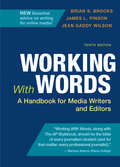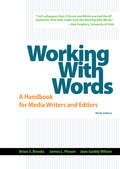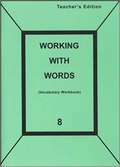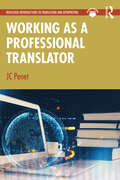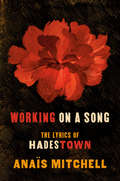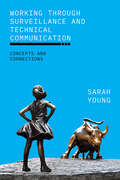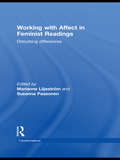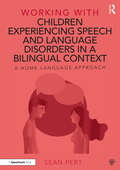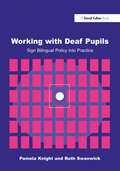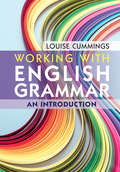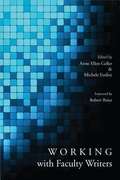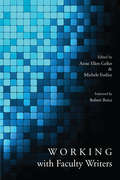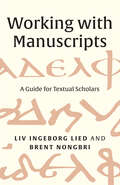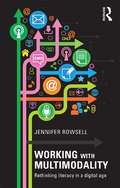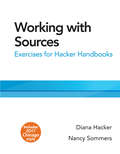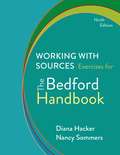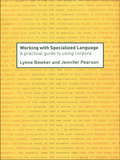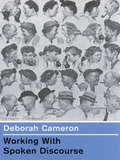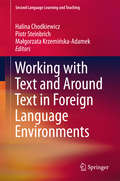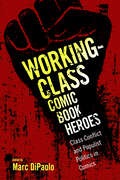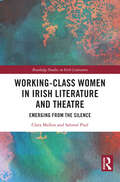- Table View
- List View
Working With Words: A Handbook For Media Writers And Editors
by Jean Wilson Brian Brooks James PinsonWorking With Words: A Handbook for Media Writers and Editors
by Brian S. Brooks Jean Gaddy Wilson James L. PinsonNo matter the medium—from print to broadcast to digital—Working With Words presents the best writing advice for today’s journalists. The text’s focus on improving skills in grammar and style make this an invaluable reference for students from their introductory journalism courses throughout their future careers in the field. With extensive coverage of grammar, mechanics and usage, as well as style, unbiased writing and writing for different media, Working With Words includes material that students cannot find in the Associated Press Stylebook alone. New with the ninth edition, Working with Words can be packaged with LaunchPad Solo for Journalism, where students can access the Exercise Book for Working With Words – an interactive workbook with multiple activities matching each chapter topic in the main text. Also on LaunchPad, students can further their grammar practice with Exercise Central for AP Style, and watch numerous videos from renowned journalists.
Working With Words: Vocabulary Workbook
by PathwayTest related to 47 Lessons each lesson is divided into 3 parts.
Working as a Professional Translator (Routledge Introductions to Translation and Interpreting)
by JC PenetWhat does it take to be a professional translator in the 21st century? What are the opportunities and challenges of a career in translation? How do you find that first job? How do you ensure that work remains sustainable over time? Combining industry insights, the latest research in the field of translation studies and a career coaching approach, this textbook takes aspiring translators on an explorative journey that helps them answer these questions for themselves so they can become the professional translators they aspire to be.Each chapter of this hands-on guide opens with key questions that budding translators might typically ask themselves and encourages them to reflect on their relevance for their own situation through regular discussion points and ‘Topics for discussion and assignments’. Targeted suggestions for further reading at the end of each chapter guide users in deepening their knowledge. Written primarily for students on translation courses, the accessible language, tone and design of this book will appeal to anyone who is thinking of embarking upon a career in translation. Additional resources are available on the Routledge Translation Studies Portal.
Working on a Song: The Lyrics of HADESTOWN
by Anaïs MitchellAnaïs Mitchell named to TIME's List of the 100 Most Influential People in the World of 2020An illuminating book of lyrics and stories from Hadestown—the winner of eight Tony Awards, including Best Musical—from its author, songwriter Anaïs Mitchell with a foreword by Steve Earle On Broadway, this fresh take on the Greek myth of Orpheus and Eurydice has become a modern classic. Heralded as &“The best new musical of the season,&” by The Wall Street Journal, and &“Sumptuous. Gorgeous. As good as it gets,&” by The New York Times, the show was a breakout hit, with its poignant social commentary, and spellbinding music and lyrics. In this book, Anaïs Mitchell takes readers inside her more than decade&’s-long process of building the musical from the ground up—detailing her inspiration, breaking down the lyrics, and opening up the process of creation that gave birth to Hadestown. Fans and newcomers alike will love this deeply thoughtful, revealing look at how the songs from &“the underground&” evolved, and became the songs we sing again and again.
Working the Garden
by William ConlogueIn 1860 farmers accounted for 60 percent of the American workforce; in 1910, 30.5 percent; by 1994, there were too few to warrant a separate census category. The changes wrought by the decline of family farming and the rise of industrial agribusiness typically have been viewed through historical, economic, and political lenses. But as William Conlogue demonstrates, some of the most vital and incisive debates on the subject have occurred in a site that is perhaps less obvious--literature. Conlogue refutes the critical tendency to treat farm-centered texts as pastorals, arguing that such an approach overlooks the diverse ways these works explore human relationships to the land. His readings of works by Willa Cather, Ruth Comfort Mitchell, John Steinbeck, Luis Valdez, Ernest Gaines, Jane Smiley, Wendell Berry, and others reveal that, through agricultural narratives, authors have addressed such wide-ranging subjects as the impact of technology on people and land, changing gender roles, environmental destruction, and the exploitation of migrant workers. In short, Conlogue offers fresh perspectives on how writers confront issues whose site is the farm but whose impact reaches every corner of American society.
Working through Surveillance and Technical Communication: Concepts and Connections (SUNY series, Studies in Technical Communication)
by Sarah YoungWhat is surveillance, and why should we care? Why are those who use technology susceptible to being both agents and targets of contemporary surveillance practices? Working Through Surveillance and Technical Communication addresses these questions, discussing what it means to engage in surveillance, examining why this participation may be problematic, and offering entry points into assessing one's ethical and socially just involvement with surveillance. Further, the book suggests ways to resist both individually and collectively, and it offers pedagogical entry points for those looking to talk about surveillance with others. Led by the central questions, "How are technical communicators also surveillance workers?" and "Why does this matter for technical communication and surveillance scholarship?" the text uses the example of Edward Snowden to illustrate how technical communicators and surveillance workers exist on an often-overlapping range. Sarah Young highlights the potentially discriminatory nature of surveillance and argues that recognizing and evaluating surveillance in is increasingly important in a data-driven world.Open Access funded by Erasmus University Rotterdam Library in support of open science initiatives. It can be found in the SUNY Open Access Repository at https://soar.suny.edu/handle/20.500.12648/8546.
Working with Affect in Feminist Readings: Disturbing Differences (Transformations)
by Marianne LiljeströmAffect has become something of a buzzword in cultural and feminist theory during the past decade. References to affect, emotions and intensities abound, their implications in terms of research practices have often remained less manifest. Working with Affect in Feminist Readings: Disturbing Differences explores the place and function of affect in feminist knowledge production in general and in textual methodology in particular. With an international group of contributors from studies of history, media, philosophy, culture, ethnology, art, literature and religion, the volume investigates affect as the dynamics of reading, as carnal encounters and as possibilities for the production of knowledge. Working with Affect in Feminist Readings asks what exactly are we doing when working with affect, and what kinds of ethical, epistemological and ontological issues this involves. Not limiting itself to descriptive accounts, the volume takes part in establishing new ways of understanding feminist methodology.
Working with Children Experiencing Speech and Language Disorders in a Bilingual Context: A Home Language Approach (Working With)
by Sean PertThe complexity of speech and language disorders can be daunting in a monolingual context. When working with a bilingual child assessment and intervention may appear to be even more complicated. In this book Sean Pert provides the reader with the tools needed to overcome this perception and develop skills in working in a language that they don’t share with the client. By adopting a home language first approach the book discusses how to: identify diversity from disorder introduce effective approaches in line with the best clinical practice work successfully alongside interpreters make assessments and plan interventions set goals for therapy. At the heart of the text is the therapist creating essential partnerships with parents and truly valuing the bilingualism, culture and identity of the child. This leads to better outcomes, not only in speech, language and communication, but also in self-esteem, mental health, social participation and educational and employment success. The book concludes with a handy toolkit of resources including quizzes, case studies and printable extras making it the perfect resource for both experienced and newly qualified practitioners with bilingual and multilingual children in their care.
Working with Deaf Children: Sign Bilingual Policy into Practice
by Pamela Knight Ruth SwanwickThis book is essential and accessible reading for all teachers and professionals who are working with sign bilingual deaf children. It considers the background and theory underpinning current developments in sign bilingual education and the implications for policy and developing classroom practice. Practical teaching strategies are suggested and evaluated. The authors draw on their own experience of working in sign bilingual settings as well as current good practice and relevant research. This book is the first UK book that describes sign bilingual education (beyond policy). It is also the first book to support sign bilingual practice dealing with current educational issues. The authors draw together relevant research and practice in sign bilingual education and present practical strategies for teachers.
Working with English Grammar: An Introduction
by Louise CummingsThis clear and concise introduction offers students of linguistics and English language a comprehensive overview of English grammar, including word structure, major and minor word classes, phrases, clauses and sentences. Based on twenty years' teaching practice, Louise Cummings adopts a unique approach of using three real-world contexts - first language acquisition, language disorders and non-standard dialects - as a pedagogical tool to make grammatical concepts meaningful to students and to improve engagement and understanding. In seven accessible chapters, students are encouraged to develop the analytical skills they require to give a comprehensive description of the grammar of the English language. A range of supportive learning aids is used, including: • Learning objectives and section 'key points' summaries • Varied examples from world Englishes and print media • Homework assignments, exercises and revision questions • Targeted further reading suggestions and 'special topics' boxes • A glossary of 300 entries • An extensive range of online resources for instructors and students, including a test bank of 140 multiple-choice questions, useful links and an answer key.
Working with Faculty Writers
by Anne Ellen Geller Michele EodiceThe imperative to write and to publish is a relatively new development in the history of academia, yet it is now a significant factor in the culture of higher education. Working with Faculty Writers takes a broad view of faculty writing support, advocating its value for tenure-track professors, adjuncts, senior scholars, and graduate students. The authors in the volume imagine productive campus writing support for faculty and future faculty that allows for new insights about their own disciplinary writing and writing processes, as well as the development of fresh ideas about student writing. Contributors from a variety of institution types and perspectives consider who faculty writers are and who they may be in the future, reveal the range of locations and models of support for faculty writers, explore the ways these might be delivered and assessed, and consider the theoretical, philosophical, political, and pedagogical approaches to faculty writing support, as well as its relationship to student writing support. With the pressure on faculty to be productive researchers and writers greater than ever, this is a must-read volume for administrators, faculty, and others involved in developing and assessing models of faculty writing support.
Working with Faculty Writers
by Anne Ellen Geller Michele EodiceThe imperative to write and to publish is a relatively new development in the history of academia, yet it is now a significant factor in the culture of higher education. Working with Faculty Writers takes a broad view of faculty writing support, advocating its value for tenure-track professors, adjuncts, senior scholars, and graduate students. The authors in this volume imagine productive campus writing support for faculty and future faculty that allows for new insights about their own disciplinary writing and writing processes, as well as the development of fresh ideas about student writing. Contributors from a variety of institution types and perspectives consider who faculty writers are and who they may be in the future, reveal the range of locations and models of support for faculty writers, explore the ways these might be delivered and assessed, and consider the theoretical, philosophical, political, and pedagogical approaches to faculty writing support, as well as its relationship to student writing support. With the pressure on faculty to be productive researchers and writers greater than ever, this is a must-read volume for administrators, faculty, and others involved in developing and assessing models of faculty writing support.
Working with Manuscripts: A Guide for Textual Scholars
by Brent Nongbri Liv Ingeborg LiedA first-of-its-kind handbook outlining best practices and common pitfalls for students and textual scholars interested in beginning to work with manuscripts While manuscripts are rare in most of the world today, they were once ubiquitous. Before the printing press, literature was preserved and transmitted through handwritten copies containing variant readings, mistakes, corrections, and other unique features. Those who study premodern texts, however, often use as their primary sources not these diverse artifacts but critical editions that present a single convenient hybrid text. Brent Nongbri and Liv Ingeborg Lied argue that knowledge of manuscripts is important for all interpreters of ancient texts, even if learning how to study them can be confusing and intimidating. In this book they draw on their decades of experience with Jewish and Christian manuscripts to demystify manuscript work. Combining their interests in manuscripts as material artifacts with the ethical issues surrounding the study of manuscripts, Lied and Nongbri guide students through the main phases of research, from considerations of provenance and access to the practicalities of on-site research, analysis, and publication. The book includes aids for locating manuscripts, helpful case studies, tips for organizing data, a glossary, suggestions for further reading, and more. Written in an engaging style with students in mind, this handbook provides an invaluable resource for anyone who wants to study a manuscript for the first time.
Working with Multimodality: Rethinking Literacy in a Digital Age
by Jennifer RowsellIn today’s digital world, we have multiple modes of meaning-making: sounds, images, hypertexts. Yet, within literacy education, even ‘new’ literacies, we know relatively little about how to work with and produce modally complex texts. In Working with Multimodality, Jennifer Rowsell focuses on eight modes: words, images, sounds, movement, animation, hypertext, design and modal learning. Throughout the book each mode is illustrated by cases studies based on the author’s interviews with thirty people, who have extensive experience working with a mode in their field. From a song writer to a well known ballet dancer, these people all discuss what it means to do multimodality well. This accessible textbook brings the multiple modes together into an integrated theory of multimodality. Step-by-step, beginning with theory then exploring modes and how to work with them, before concluding with how to apply this in an investigation, each stage of working with multimodality is covered. Working with Multimodality will help students and scholars to: • Think about specific modes and how they function • Consider the implications for multimodal meaning-making • Become familiar with conventions and folk knowledge about given modes • Apply this same knowledge to their own production of media texts in classrooms Assuming no prior knowledge about multimodality and its properties, Working with Multimodality is designed to appeal to advanced undergraduate and postgraduate students interested in how learning and innovation is different in a digital and media age and is an essential textbook for courses in literacy, new media and multimodality within applied linguistics , education and communication studies.
Working with Sources
by Diana Hacker Nancy SommersThis useful workbook includes 60 exercise sets designed to give students practice with key research skills in MLA, APA, and Chicago styles. Topics include forming research questions and thesis statements, integrating sources, and avoiding plagiarism. The answer key, in the back of the book, provides specific feedback for each answer.
Working with Sources: Exercises for The Bedford Handbook (Ninth Edition)
by Diana HackerThis useful workbook includes 60 exercise sets designed to give students practice with key research skills in MLA, APA, and Chicago styles. Topics include forming research questions and thesis statements, integrating sources, and avoiding plagiarism.
Working with Specialized Language: A Practical Guide to Using Corpora
by Lynne Bowker Jennifer PearsonWorking with Specialized Language: a practical guide to using corpora introduces the principles of using corpora when studying specialized language. The resources and techniques used to investigate general language cannot be easily adopted for specialized investigations. This book is designed for users of language for special purposes (LSP). Providing guidelines and practical advice, it enables LSP users to design, build and exploit corpus resources that meet their specialized language needs. Highly practical and accessible, the book includes exercises, a glossary and an appendix describing relevant resources and corpus-analysis software. Working with Specialized Language is ideal for translators, technical writers and subject specialists who are interested in exploring the potential of a corpus-based approach to teaching and learning LSP.
Working with Spoken Discourse
by Deborah CameronWorking with Spoken Discourse provides a comprehensive account of the expanding multidisciplinary field of discourse analysis. Combining theory and practice it covers a wide range of material in a lively and accessible style. It discusses current approaches, concepts and debates in the field of spoken discourse and provides a grounding in the practical techniques of discourse analysis and how to apply them to real data. Working with Spoken Discourse is divided into three sections. The first section covers general issues - the definition of `discourse' and uses of discourse analysis, the second section covers a series of approaches to discourse analysis and the final section focuses on the applications of discourse analysis in social research and designing and writing up projects.
Working with Text and Around Text in Foreign Language Environments
by Halina Chodkiewicz Piotr Steinbrich Małgorzata Krzemińska-AdamekThis book investigates the three pivotal points oftext for foreign language acquisition: reception, construction and deconstruction. InPart One, the focus is on various aspects of text reception, such as developingliteracy, text interest, and perceptions of the academic register or theassessment of spoken language in educational contexts. Part Two deals withvarious aspects of composing text, such as author identity, lexical constructsor collaborative web-based writing. Lastly, Part Three presents the varioussegmental items that constitute text, like lexical clustering, L1/L2relationship, classroom talk as text, etc. The division corresponds with whatcan be viewed as a logical sequence of text-related processes reflected informal learning and teaching environments.
Working with Words: Pathway Vocabulary Workbook (Grade 6)
by Pathway PublishersThis workbook is designed especially for Amish Parochial schools to enrich the pupils' vocabulary and open the way to better reading comprehension. Lessons and instructions are so simple that the pupil will be able to benefit from the work with a minimum of teacher supervision. Even though approximately 75% of the words introduced in this book are taken from the stories in Pathway's sixth grade reader, STEP BY STEP, this workbook can be used with any reading book.
Working-Class Comic Book Heroes: Class Conflict and Populist Politics in Comics
by Marc DiPaoloContributions by Phil Bevin, Blair Davis, Marc DiPaolo, Michele Fazio, James Gifford, Kelly Kanayama, Orion Ussner Kidder, Christina M. Knopf, Kevin Michael Scott, Andrew Alan Smith, and Terrence R. WandtkeIn comic books, superhero stories often depict working-class characters who struggle to make ends meet, lead fulfilling lives, and remain faithful to themselves and their own personal code of ethics. Working-Class Comic Book Heroes: Class Conflict and Populist Politics in Comics examines working-class superheroes and other protagonists who populate heroic narratives in serialized comic books. Essayists analyze and deconstruct these figures, viewing their roles as fictional stand-ins for real-world blue-collar characters.Informed by new working-class studies, the book also discusses how often working-class writers and artists created these characters. Notably Jack Kirby, a working-class Jewish artist, created several of the most recognizable working-class superheroes, including Captain America and the Thing. Contributors weigh industry histories and marketing concerns as well as the fan community's changing attitudes towards class signifiers in superhero adventures.The often financially strapped Spider-Man proves to be a touchstone figure in many of these essays. Grant Morrison's Superman, Marvel's Shamrock, Alan Moore and David Lloyd's V for Vendetta, and The Walking Dead receive thoughtful treatment. While there have been many scholarly works concerned with issues of race and gender in comics, this book stands as the first to deal explicitly with issues of class, cultural capital, and economics as its main themes.
Working-Class Women in Irish Literature and Theatre: Emerging from the Silence (Routledge Studies in Irish Literature)
by Clara Mallon and Salomé PauWorking-Class Women in Irish Literature and Theatre critically engages with works of theatre both by and about working-class women, historically and presently. Addressing professional and community theatre productions, from both textual and performative perspectives, this volume focuses on works of theatre by practitioners, directors, playwrights, and performance artists across rural and urban contexts. Irish theatre has a long history of signifying social class. Yet the representations of working-class women in Irish theatrical history also encompass several problematic issues, starting with the fact that these depictions were created by male writers like J. M Synge and Seán O'Casey to name but a few. Nonetheless, the theatre’s emphasis on embodied performance and its ability to reach its public in an unmediated way has attracted working-class engagement perhaps more than other art forms in Ireland. Contemporary playwrights in the Republic and the north of Ireland have tirelessly striven to illuminate working-class women’s lived experiences and have reframed the characterisation of working-class women by drawing out the intersection of social class with sexualities, ethnic minorities, and racial identities. This edited collection also includes the voices of directors, playwrights, and performers who identify with a working-class social background, offering first-hand accounts of their lived experience in the theatre industry.
Working-Class Writing: Theory and Practice
by Ben Clarke Nick HubbleThis book updates our understanding of working-class fiction by focusing on its continued relevance to the social and intellectual contexts of the age of Trump and Brexit. The volume draws together new and established scholars in the field, whose intersectional analyses use postcolonial and feminist ideas, amongst others, to explore key theoretical approaches to working-class writing and discuss works by a range of authors, including Ethel Carnie Holdsworth, Jack Hilton, Mulk Raj Anand, Simon Blumenfeld, Pat Barker, Gordon Burn, and Zadie Smith. A key informing argument is not only that working-class writing shows ‘working class’ to be a diverse and dynamic rather than monolithic category, but also that a greater critical attention to class, and the working class in particular, extends both the methods and objects of literary studies. This collection will appeal to students, scholars and academics interested in working-class writing and the need to diversify the curriculum.
